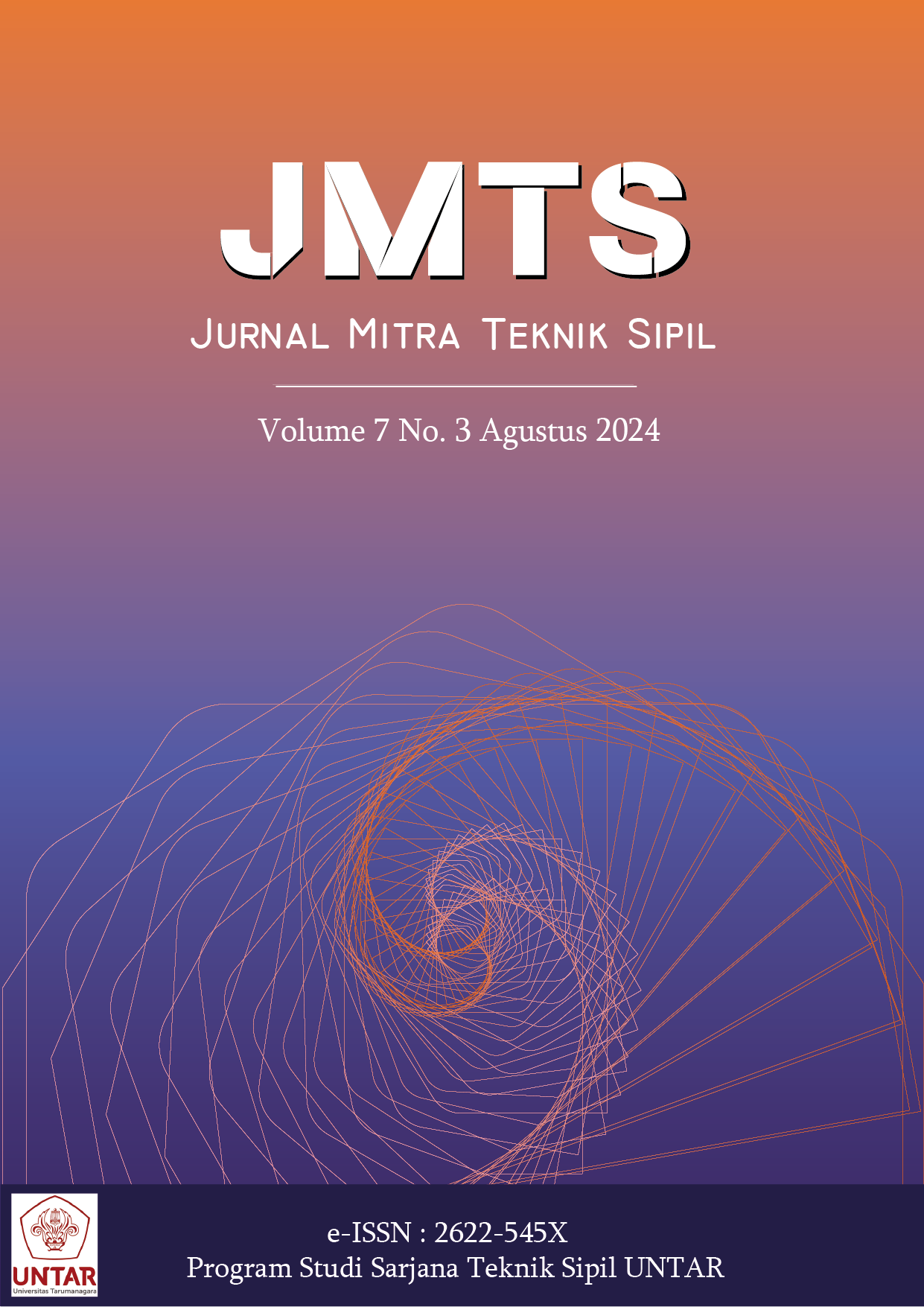PERHITUNGAN PREDIKSI DURASI PROYEK GEDUNG BERTINGKAT MENGGUNAKAN METODE EARNED SCHEDULE
Main Article Content
Abstract
One quick way to address urban population growth is to support the construction of tall buildings. This research was designed using quantitative method. The purpose of this study is to predict the duration per meter2 of high-rise building construction based on the gross floor area (GFA) and the number of levels worked on for Jakarta and surrounding areas. Data collection on the duration of ongoing projects as many as 36 projects. The data analysis procedure goes through the stages of collecting data on the duration of real and ongoing projects with the calculation of the Earned Schedule method, validating data using the Altman Z score method, analyzing the relationship between duration and gross floor area (GFA) and number of levels, and testing the feasibility of the analysis results. From the results of this study, a fairly good correlation coefficient (R) of 0.906 was obtained, which means that the correlation between the dependent variable and the two independent variables is very strong. The coefficient of determination (R2) is 0.821 or 82.1%, indicating that the independent variables are able to explain the duration prediction very well. This research produces a prediction model of duration per meter2 of multi-storey building construction based on gross floor area (GFA) and number of levels.
Abstrak
Salah satu cara cepat untuk mengatasi pertumbuhan populasi perkotaan yakni mendukung pembangunan bangunan tinggi. Penelitian ini dirancang dengan metode kuantitatif. Tujuan penelitian ini adalah untuk memprediksi durasi per meter2 konstruksi bangunan gedung bertingkat berdasarkan luas lantai dan jumlah lantai yang dikerjakan untuk daerah Jakarta dan sekitarnya. Pengumpulan data durasi proyek tengah berjalan sebanyak 36 proyek. Prosedur analisis data melalui tahapan pengumpulan data durasi proyek nyata maupun berjalan dengan perhitungan metode Earned Schedule, validasi data dengan metode uji selisih rata-rata, analisis hubungan antara durasi dengan luas lantai dan tinggi lantai, dan uji kelayakan hasil analisis. Dari hasil penelitian ini diperoleh nilai koefisien korelasi (R) yang cukup baik sebesar 0.906 mengartikan bahwa korelasi antara variabel dependen dengan kedua variabel independen termasuk sangat kuat. Koefisien determinasi (R2) sebesar 0.821 atau 82.1%, menunjukkan variabel independen mampu menjelaskan prediksi durasi dengan sangat baik. Penelitian ini menghasilkan model prediksi durasi per meter2 konstruksi bangunan gedung bertingkat berdasarkan luas lantai dan jumlah lantai.
Article Details

This work is licensed under a Creative Commons Attribution-NonCommercial-ShareAlike 4.0 International License.
This work is licensed under Jurnal Mitra Teknik Sipil (JMTS) Creative Commons Attribution-ShareAlike 4.0 International License.References
Anondho, B., Soeleiman, L., Latief, Y., & Mochtar, K. (2022). The influence of external factors on construction project performance based on estimated duration in Jakarta. International Journal of Construction Management, 23(13).
Gane, V., & Haymaker, J. (2010). Benchmarking Current Conceptual High-Rise Design Processes. Journal of Architectural Engineering, 16(3), 100–111.
Ledger, T. Y. (2021, March). Urban Sprawl: A Growing Problem. https://campuspress.yale.edu/ledger/urban-sprawl-a-growing-problem/
Lipke, W. (2012). Earned Schedule: Contribution to Project Management. PM World Jornal, 1(2), 1–19.
Lipke, W. (2019). Earned Schedule Forecasting Method Selection 1. PM World Journal Earned Schedule Forecasting Method Selection, 8(1), 1–15.
Nguyen, L. D., Phan, D. H., & Tang, L. C. M. (2013). Simulating Construction Duration for Multistory Buildings with Controlling Activities. Journal of Construction Engineering and Management, 139(8), 951–959.
OECD. (2018). Rethinking Urban Sprawl: Moving Towards Sustainable Cities. OECD Publishing.
Sugiyono, D. (2012). Metode Penelitian Kuantitatif, Kualitatif, dan Tindakan. Alfabeta, CV.
Van Bavel, J. (2013). The world population explosion: causes, backgrounds and -projections for the future. Facts, Views & Vision in ObGyn, 5(4), 281–291.



